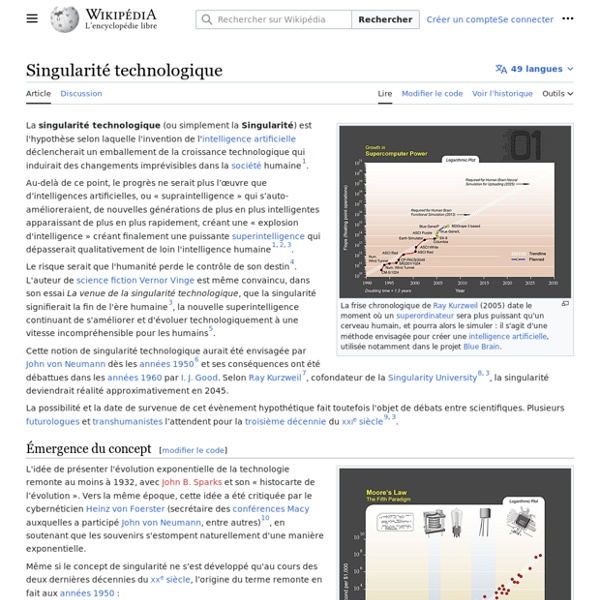



https://fr.wikipedia.org/wiki/Singularit%C3%A9_technologique
Related: Intelligence artificielle • IA • IA / Singularité / TranshumanismeAn Overview of National AI Strategies – Politics + AI The race to become the global leader in artificial intelligence (AI) has officially begun. In the past fifteen months, Canada, China, Denmark, the EU Commission, Finland, France, India, Italy, Japan, Mexico, the Nordic-Baltic region, Singapore, South Korea, Sweden, Taiwan, the UAE, and the UK have all released strategies to promote the use and development of AI. No two strategies are alike, with each focusing on different aspects of AI policy: scientific research, talent development, skills and education, public and private sector adoption, ethics and inclusion, standards and regulations, and data and digital infrastructure.
KLM now uses Facebook Messenger for boarding passes, flight info, and customer service Facebook and KLM airlines have formally announced a partnership that will allow KLM customers to receive flight confirmations, boarding cards, reminders, flight status updates, and customer service directly through the Facebook Messenger app. At its F8 developer conference last year, the social networking giant first unveiled plans to expand Messenger beyond a simple messaging app and into a platform — one that can be used to power and underpin myriad third-party services. Retailers Everlane and Zulily were among the first partners announced, though it was later revealed that KLM would be added to the mix too.
Wired 8.04: Why the future doesn't need us. Why the future doesn't need us. Our most powerful 21st-century technologies - robotics, genetic engineering, and nanotech - are threatening to make humans an endangered species. By Bill Joy From the moment I became involved in the creation of new technologies, their ethical dimensions have concerned me, but it was only in the autumn of 1998 that I became anxiously aware of how great are the dangers facing us in the 21st century. I can date the onset of my unease to the day I met Ray Kurzweil, the deservedly famous inventor of the first reading machine for the blind and many other amazing things. Ray and I were both speakers at George Gilder's Telecosm conference, and I encountered him by chance in the bar of the hotel after both our sessions were over.
′Hi, A.I.′: Exploring our relationship with robots DW: In your film, Hi, A.I. which won the Max Ophüls Prize for best documentary film, you feature a few examples from Japan, the USA, and other countries. Take us with you on your journey to the robots. Start in America. Isa Willinger: In America, we see a man meeting a robot wife. He picks her up at the factory and then goes through the first week of their "relationship." He goes on a journey with her, a road-trip through the USA.
In AI, Russia Is Hustling to Catch Up Putin is spurring frenetic efforts to marshal the country’s academic and industrial resources for breakthroughs in the field — and just might achieve them. When Vladimir Putin said last fall that artificial intelligence is “humanity’s future” and that the country that masters it will “get to rule the world,” some observers guessed that the Russian president was hinting at unrevealed progress and breakthroughs in the field. But a glance at publicly available statistics indicates otherwise. Russia’s annual domestic investment in AI is probably around 700 million rubles ($12.5 million) – a paltry sum next to the billions being spent by American and Chinese companies.
Introduction to Artificial Intelligence for UX Designers If you work in the world of product design, you’re probably hearing a lot about how artificial intelligence (AI) is going to change everything in the next few years. If you don’t have a grasp of what AI is and how it works, you may worry that you’re behind. This article should help you understand the basics of AI and feel that you, as a designer, are not actually that far behind (I can’t say the same for developers). It takes a little bit of work to get through this article, but after reading it you should feel that you are capable of designing for new developments in AI. Although the title of this article is “Artificial Intelligence for UX designers,” we can’t get to the “for UX Designers” part until we discuss what AI is and how it works, at least at a basic level (the “designing for AI” courses at MIT and Bentley follow the same structure).
The Singularity Is Not Near What's the Latest Development? Professor of neuroscience at Johns Hopkins University, David Linden doesn't believe man will be fused with machine any time soon. At least not in the way that futurist Ray Kurzweil envisions the (near) future. One of Kurzweil's predictions is that by the 2020s, minuscule nano-robots will enter our brains, non-invasively through our capillaries, and be able to manipulate our sensory receptors to create the first true virtual reality. A neural net solves the three-body problem 100 million times faster In the 18th century, the great scientific challenge of the age was to find a way for mariners to determine their position at sea. One of the most successful solutions was to measure the position of the moon in the sky relative to the fixed background of stars. Because of parallax effects, this measurement depends on the observer’s position.